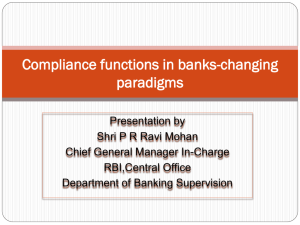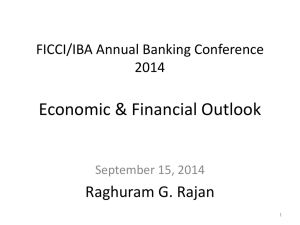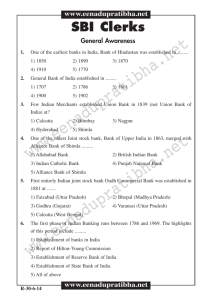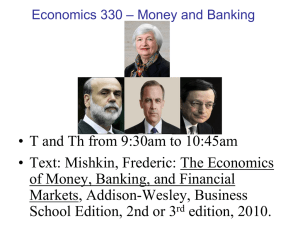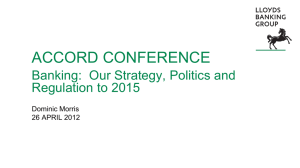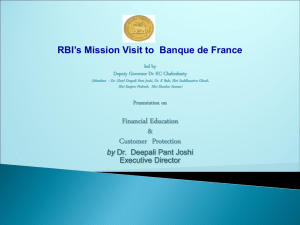V.Ramkumar part-1 - Sa-Dhan
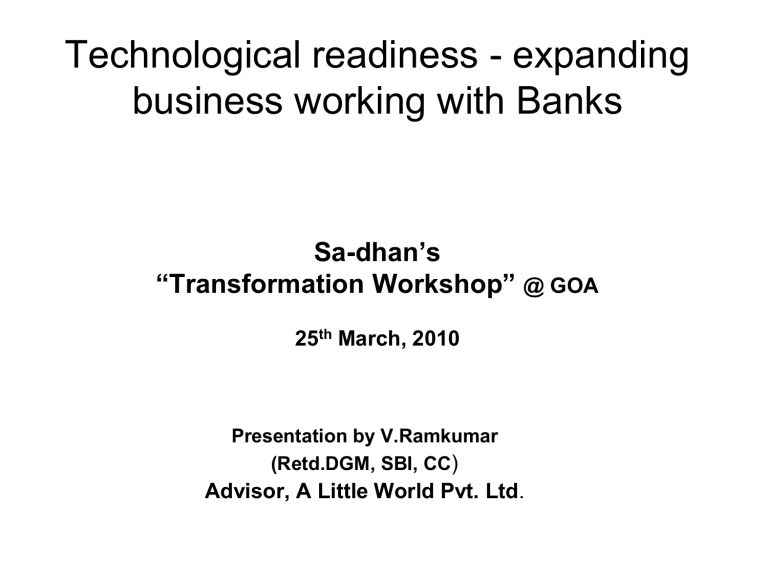
Technological readiness - expanding business working with Banks
Sadhan’s
“Transformation Workshop”
@ GOA
25 th March, 2010
Presentation by V.Ramkumar
(Retd.DGM, SBI, CC )
Advisor, A Little World Pvt. Ltd .
EMERGENCE OF
BRANCHLESS BANKING
RBI introduced the “Business Correspondent model” in 2006 - a new model of branchless banking for Indian banks.
BC model aims to promote banks offering financial products, especially savings accounts, to previously un-reached population.
Promoting banking with low capital cost by enabling outsourcing of rural business to agents on a commission basis.
RBI laid down criteria for the type of entities/individuals eligible to be engaged by Banks to outsource transaction processing.
Distance criteria also was laid down in regard to the location of the agents engaged by the bank branches.
RBI also stipulated that the information on all transactions must be updated in bank’s Core Banking System by end of the day
2
FI : RBI GUIDELINES
• Introduction of BC/ BF Model
• Use of Information Technology: Smart cards for opening bank accounts with biometric identification and mobile banking etc.
• Simpler KYC Norms
• No-Frills accounts
• General purpose Credit Cards (GCC)
• SLBC Project of 100% Financial Inclusion. All house-holds in villages with more than 2000 inhabitants should have bank accounts by March 2011.
• F.I. Fund / F.I. Technology Fund
(Budget allocation increased by Rs. Cr)
• Financial Literacy - Credit Counseling Centre
GoI’s Guidelines
• Opening of atleast 250 household accounts by RUSU branches.
(Rangarajan Committee recommendations).
3
WHAT HAS BEEN DONE SO FAR
The BC/BF channel is still in its nascent stage and is being built-up.
Many Banks launched Pilots and are in the learning curve.
There has been some progress in
Engagement of BCs/BFs
'No Frills' Accounts being opened
Smart Cards being issued
Unbanked villages being covered
Financial Literacy Credit Counselling Centres being established.
Technology:
Disbursement of various Government benefit scheme payments through smart card technology by various banks.
Kiosk banking.
Introduction of few Bio-metric ATMs
4
TRANSFORMATION
WHY & FOR WHOM ?(1)
• If one’s ultimate goal is providing access to a range of financial services to the disadvantaged sections of society , at a low cost , at the nearest place and at a convenient time,
– there is no alternative as on date to implementing wholeheartedly the BC model.
• The mind-set “BC is not viable and it is somebody other than us to make it viable” to go for those who are to implement the model.
• NGOs to leave the “mission drift” approach and MFIs the “instant business opportunity” mode to allow transformation of “beneficiaries into clients” by taking up the BC route for realising their objective of poverty alleviation.
• FI implementation literacy to stake holders to precede FIL for poor.
TRANSFORMATION
WHY & FOR WHOM? (2)
• The technology enablers looking at FI from a business perspective of long term profitability have to “stay some where” for “some time”
to allow consolidation and move away from “ever changing”, for the sake of changing” mode.
• Banks to shed “banking to the poor is not poor banking” mind set and own up FI as their ordained role.
• Govt to go beyond seeing FI as a “primary mechanism for Govt.
Benefit transfer”mode, providing gradually relaxed and evolving regulatory frameworks and sporadic fund support mostly in very small pilots.
• NABARD to provide adequate and quick fund support to Banks in reimbursing the promotional cost incurred
EMERGING SCENERIO(1)
• GOI ‘s UID with “bank account free” plans – No KYC, nominal sum as incentive to individuals for opening account.
• GOI’s proposed incentive of Rs.1000 per annum for each pension fund a/c opened by people from the organised sector
• GOI’s plans for full migration to smart-card based EBT system for
NREGS and route more welfare scheme payments through this channel
• GOI introducing an index to assess financial inclusion on a quarterly basis from June 2010 onwards to aid RBI / GOI to take timely and area specific measures to drive financial inclusion better.
• GOI initiating creation of Post Bank of India
EMERGING SCENERIO (2)
• GOI mulling over providing a common technology platform to aid banks reach out to the poorest at low cost
• 3G Spectrum & BSNL, MTNL broad band brand width on the anvil
• Self-regulatory body MFIN set up by 31 MF-NBFCs
• MFIN &CIBIL tie-up for setting up a Credit Bearu for the MF sector
• Mobile cos trying to get payment gateway licence from RBI to cover unbanked areas as RBI favour banks doing payment business
• State Govts. providing interest subvention for bank loans to SHGs
• Introduction of “savings cards” of for small amounts
EMERGING SCENERIO (3)
• Rashtriya Swasthya Bima Yojana enrolled 13 million BPL households through smart card s collecting registration fee of Rs.30 per card
• Private players entering into micro-pension, micro-insurance ,microinvestments “savings cards” , remittances ( for migrant labour) etc.
• Sa-Dhan suggesting creation of Micro Finance Credit Guarantee
Fund to provide cover for MFIs. (Can cover be extended for risk of transformation as BC?)
• National Skills Development Mission linkage with National rural
Livelihood Mission
EMERGING SCENERIO(4)
• RBI is mulling over allowing of more Local Area Banks (LABs) to provide an impetus to the Financial Inclusion drive, to be opened in unbanked or under banked areas with a higher Capital Adequacy
Ratio (CAR) than Banks.
• SMS Banking will be the order of the day with tech companies coming out with secured digital authentication and encryption of messages.
• Micro Insurance products brought out by banks like SBI’s Grameen
Shakthi are gaining slow acceptance by SHGs . Technology when used for delivery to end user, scaling up would be faster.
• Micro Investment products ,eg: SBIMF’s Chhota SIP of Rs.100 p.m etc is providing investment opportunities for the poor.
EMERGING SCENERIO (5)
• After the infrastructure sector, the public-private partnership (PPP) model will be extended to rural job generation as well.
• National Rural Livelihood Mission (NRLM) currently has 15 private partners. But the interest among private enterprises and NGOs to participate in the programme is increasing
• The PPP scheme involves private enterprises to give short duration vocational training to the rural youth
• The government bears the cost of the training as a subsidy on condition that the private parties would provide jobs to trained personnel .
ENABLERS SUM UP
.
Govt. Providing common infrastructure and technology platform.
Mainstreaming MFIs into formal banking system.
Product diversification, by Banks, Insurance and FIs.
Release of funds to Banks promptly from FIF and FITF funds.
Govt. Subsidy incentives to FI customers on transactions basis.
Financial Inclusion Implementation Literacy to all operating level stake holders.
Exempting payment of Stamp Duty for small loans.
Waiver of PAN requirement for Mutual
Funds for small amount
12
PROF : MOHAMMAD YUNUS’ - QUOTES
POOR ARE BANKABLE – EVEN BEGGARS
BANKING FOR THE POOR – NOT POOR BANKING
ACCESS TO CAPITAL, EVENON A TINY SCALE CAN HAVE A TRANSFORMING
EFFECT ON HUMAN LIVES
SOCIAL BUSINESS IS CAUSE-DRIVEN BUT NOT LOSS MAKING
I - SOCIAL OBJECTIVESS COVERING COST
II – POOR AS OWNERS DOING BUSINESS FOR PROFIT
SOCIAL BUSINESS OWNED BY THE POOR
SOCIAL BUSINESS IS NOT CHARITY – IT IS A BUSINESS IN EVERY SENSE
POOR PEOPLE OR BONSAI PEOPLE. NOTHING WRONG WITH THEIR
SEEDS.SOCIETY NEVER GAVE A BASE TO GROW ON. ENABLING
ENVIRONMENT IS THE NEED
PUTTING POVERTY IN MUSEUMS
SOCIAL STOCK MARKET – SHARES OF SOCIAL BUSINESS WILL BE TRADED
WE CREATE WHAT WE WANT OR WHAT WE DONOT REFUSE
13
14

